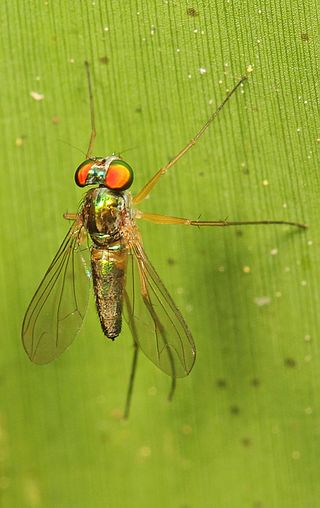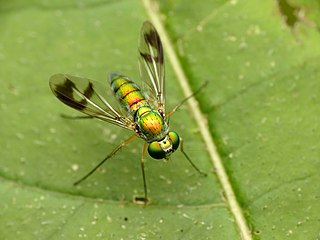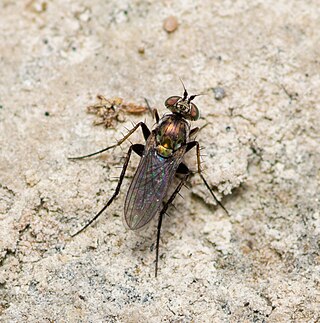
Amblypsilopus is a genus of flies in the family Dolichopodidae. It is a large genus, with about 350 species recorded. However, it is possibly polyphyletic.
Argyrochlamys is a genus of flies in the family Dolichopodidae. It is known from the Afrotropics, the Oriental realm, and the southernmost part of the Palearctic realm. The genus is closely related to the genera Pseudargyrochlamys and Phoomyia. Species of Argyrochlamys are restricted to ocean beaches, and are usually collected in the burrows of ghost crabs. Their ecological role within these burrows is currently unknown. Adults of Argyrochlamys have a non-metallic dull body color, ranging from pale yellowish brown to dark grey.
Chaetogonopteron is a genus of flies in the family Dolichopodidae.

Chrysosoma is a genus of flies in the family Dolichopodidae. It is a large genus, with more than 200 species distributed in the Old World and Oceania.

Condylostylus is a genus of flies in the family Dolichopodidae. It is the second largest genus in the subfamily Sciapodinae, with more than 250 species included. It has a high diversity in the Neotropical realm, where 70% of the species occur.
Cymatopus is a genus of flies in the family Dolichopodidae. Members of the genus are found on rocky coasts of the Indo-West Pacific.

Diaphorus is a genus of flies in the family Dolichopodidae. Lyroneurus was formerly considered a subgenus, but is now either treated as a synonym of Chrysotus or treated as a distinct genus.

Medetera is a large genus of flies in the family Dolichopodidae. It includes about 350 species worldwide. The adults are commonly found resting on vertical surfaces such as tree trunks, on which they have a characteristic vertical upright stance. Because of this stance, they are sometimes known as "woodpecker flies". Medetera adults are predators of soft-bodied arthropods, while the larvae are predators of bark beetle larvae.
Micromorphus is a genus of flies in the family Dolichopodidae.

Paraclius is a genus of flies in the family Dolichopodidae. It is currently considered a polyphyletic assemblage of species.
Plagiozopelma is a genus of flies in the family Dolichopodidae.
Saccopheronta is a genus of flies in the family Dolichopodidae. It is considered a synonym of Medetera by some authors, and a valid genus by others.

Thinophilus is a genus of flies in the family Dolichopodidae. It includes about 146 described species distributed worldwide. Most species of the genus are found in coastal habitats, while a few species are found in freshwater habitats.
Urodolichus is a genus of fly in the family Dolichopodidae. It is known from the Afrotropical realm, Indomalayan realm and Australasian realm. It has been placed in either Rhaphiinae or Diaphorinae, though Grichanov & Brooks (2017) consider the genus to be incertae sedis within the family Dolichopodidae.
Wheelerenomyia is an extinct genus of flies in the family Dolichopodidae that lived during the Eocene of the Baltic region. The genus currently contains 13 species, all of which were described from Baltic amber. Within the family Dolichopodidae, Wheelerenomyia is considered to be a member of the subfamily Sciapodinae, but its wing vein M is unbranched and strongly curved so it is considered closely related to members of the tribe Mesorhagini. The genus was first described in 1907 by Fernand Meunier, who named it after William Morton Wheeler.

Sciapodinae is a subfamily of flies in the family Dolichopodidae. Members of the subfamily possess several ancestral characteristics of the family, such as branched vein M1+2 in the wings (though M2 is absent or reduced in Mesorhagini) and a pedunculate hypopygium. They also typically have a deeply excavated vertex, giving their heads the appearance of a dumbbell when viewed from the front.

Medeterinae is a subfamily of flies in the family Dolichopodidae.

Peloropeodinae is a subfamily of flies in the family Dolichopodidae. In some classifications, the genera of the subfamily are included in Sympycninae. According to a molecular phylogenetic analysis of the family Dolichopodidae by Germann et al. (2011), the subfamily is polyphyletic.









